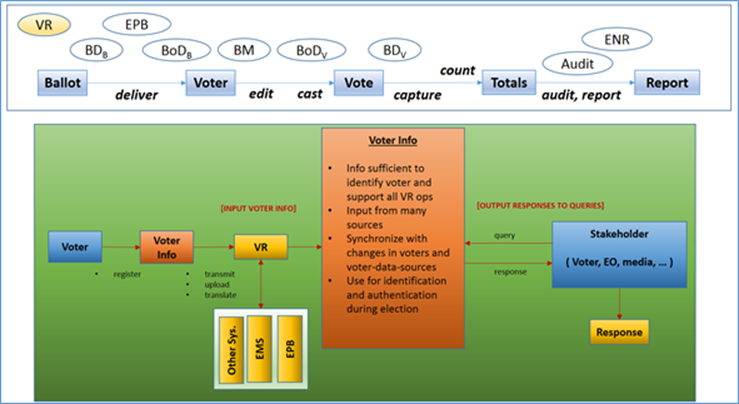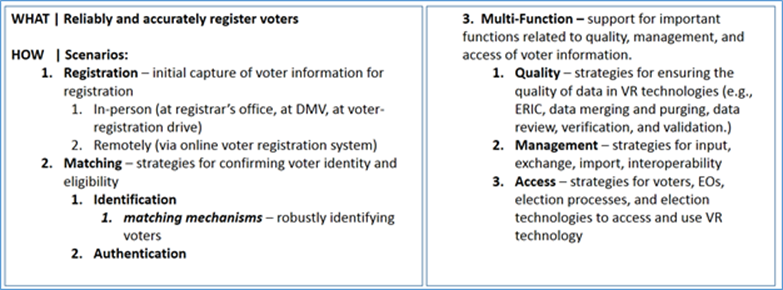Voter Registration (VR) Use Case
READ-ONLY SITE MATERIALS: Historical voting TWiki site (2015-2020) ARCHIVED from https://collaborate.nist.gov/voting/bin/view/Voting

The essence of voter registration (VR) technology is to enable all voters who are eligible to vote to become registered or to register to vote so as to be able to vote in U.S. elections. Many laws (such as the NVRA, HAVA, and others) and practices (such as voter registration drives) have come into being to make it as easy as possible for all eligible citizens to become registered to vote. This has resulted in an open-ended and evolving set of processes and systems that act as sources of voter registration data for VR systems, which also serve as drivers for the immense complexity and variation witnessed in this area.
Systems and strategies such as the Electronic Registration Information Center (ERIC) (used for data cleaning and synchronization) and NIST’s Common Data Format (CDF) (used for interoperability / data standardization) address problems arising from this variation. Due to the wide variety of data representations and dependencies, the role and necessity for strong data standardization and interoperability will be a critical factor (e.g., CDF for VR technologies). Reducing and controlling this variation is one of the strongest ways to detect and combat voter-information fraud.
VR systems may be organized in different ways – e.g., “top-down” statewide VRDBs connecting “downward” to lower-level county-level VRDBs, and “bottom-up” with information flowing in the opposition direction. They may be implemented using a broad spectrum of technologies. However, in general, their primary function is to support reliable and accurate voter registration in a very wide variety of contexts (in-person, online, etc.). They support voter registration processes occurring in many variations such as: in-person registration at registrar’s office, in-person voter registration at a Motor Vehicle Administration office, online registration, same-day voter registration, etc.
i

Use Case Scenarios
WHAT | Reliably and accurately register voters
HOW | Scenarios
-
Registration - initial capture of voter information for registration
-
In-person (at registrar's office, at DMV, at voter-registration drive)
-
Remotely (via online voter registration system)
-
-
Matching - strategies for confirming voter identity and eligibility
-
Identification
-
matching mechanisms - robustly identifying voters
-
-
Authentication
-
-
Multi-Function - support for important functions related to quality, management, and access of voter information
-
Quality - strategies for ensuring the quality of data in VR technologies (e.g., ERIC, data merging and purging, data review, verification, and validation)
-
Management - strategies for input, exchange, import, interoperability
-
Access - strategies for voters, EOs, election processes, and election technologies to access and use VR technology
-
Request for Feedback
For each use case scenario, please address these questions:
- Is the use case scenario in scope for the Next Generation VVSG for development of requirements that will undergo testing and certification? or
- Is the use case scenario in scope to develop as guidelines for election officials and voting system manufacturers? or
- Is the use case scenario not in scope for this work?
- If different parts of the use case scenario fall in 1., 2., and/or 3. Please identify as such.
Voting TWiki Archive (2015-2020): read-only, archived wiki site, National Institute of Standards and Technology (NIST)
ARCHIVE SITE DESCRIPTION AND DISCLAIMER
This page, and related pages, represent archived materials (pages, documents, links, and content) that were produced and/or provided by members of public working groups engaged in collaborative activities to support the development of the Voluntary Voting System Guidelines (VVSG) 2.0. These TWiki activities began in 2015 and continued until early 2020. During that time period, this content was hosted on a Voting TWiki site. That TWiki site was decommissioned in 2020 due to technology migration needs. The TWiki activities that generated this content ceased to operate actively through the TWiki at the time the draft VVSG 2.0 was released, in February of 2020. The historical pages and documents produced there have been archived now in read-only, static form.
- The archived materials of this TWiki (including pages, documents, links, content) are provided for historical purposes only.
- They are not actively maintained.
- They are provided "as is" as a public service.
- They represent the "work in progress" efforts of a community of volunteer members of public working groups collaborating from late 2015 to February of 2020.
- These archived materials do not necessarily represent official or peer-reviewed NIST documents nor do they necessarily represent official views or statements of NIST.
- Unless otherwise stated these materials should be treated as historical, pre-decisional, artifacts of public working group activities only.
- NIST MAKES NO WARRANTY OF ANY KIND, EXPRESS, IMPLIED OR STATUTORY, INCLUDING, WITHOUT LIMITATION, THE IMPLIED WARRANTY OF MERCHANTABILITY, FITNESS FOR A PARTICULAR PURPOSE, NON-INFRINGEMENT AND DATA ACCURACY.
- NIST does not warrant or make any representations regarding the correctness, accuracy, reliability or usefulness of the archived materials.
ARCHIVED VOTING TWIKI SITE MATERIALS
This wiki was a collaborative website. NIST does not necessarily endorse the views expressed, or concur with the facts presented on these archived TWiki materials. Further, NIST does not endorse any commercial products that may be mentioned in these materials. Archived material on this TWiki site is made available to interested parties for informational and research purposes. Materials were contributed by Participants with the understanding that all contributed material would be publicly available. Contributions were made by Participants with the understanding that that no copyright or patent right shall be deemed to have been waived by such contribution or disclosure. Any data or information provided is for illustrative purposes only, and does not imply a validation of results by NIST. By selecting external links, users of these materials will be leaving NIST webspace. Links to other websites were provided because they may have information that would be of interest to readers of this TWiki. No inferences should be drawn on account of other sites being referenced, or not referenced, from this page or these materials. There may be other websites or references that are more appropriate for a particular reader's purpose.

